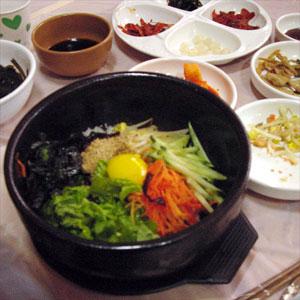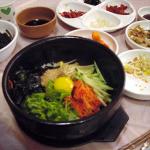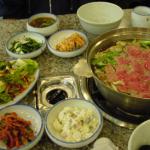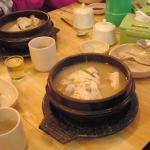A Bite of Korea
Staying in a multicultural country such as Malaysia has made my taste bud quite adventurous and my tummy rather tough in handling just about any weird foods there are out there. We have the spiciest, saltiest, sourest, and sweetest... you name it. We have Chinese, Malay, Indian, Japanese, Punjab, Western, fusion, etc... whatever. However, there is just one kind of food that Malaysia lacks and that is Korean food. No, don't get me wrong. We do have some Korean meals here, but the really good ones? They are quite hard to come by and are mainly found in the capital city only. Not only that, they are expensive too. For the longest time, I have always wondered if the ones I taste back home are truly authentic or perhaps already tarnish with external ethnic influences.
My questions were answered during my last trip to Korea, and what a great time I had! The Koreans have been eating the produce from the sea, field and mountain for the longest time, and thanks to their climate, foods are readily available. Generally, Korean food is quite special in its own ways, exotic to a certain extent and particularly standard on other occasion. However, there are two common factors in their dishes. Firstly, they are spicy. Second, sour. Its meals have certain basic seasonings such as red pepper, vinegar, wine, ginger, sesame, fermented bean paste, soy sauce, green onion, garlic and mustard. Funnily, such "pungent" flavorings when combined together could enhance their food and give them its uniqueness that is almost similar but different from their neighbors, Japan.
In a Korean diet, grains, vegetables and meats are the three main aspects. Most Korean food is low in fat, has a sweet taste and has moderate amount of calories. They are, in other words, healthy and well balanced. One of the most significant identities of Korean meals is their need for various (or I could say many) side dishes. Common side dishes include the infamous kimchi, broiled fish, cabbage, beef and steamed vegetables. For soup, a miso-like soup (bean-based) is common. A full course Korean meal is known as Hanjoungshik, which comprises of grilled fish, steamed short ribs and some other meat and vegetable dishes. Eat all that with steamed white rice, soup and kimchi.
Anyone who is not familiar with Korean food will somehow have heard of kimchi. It has got to be the most well known Korean food. A vegetable dish, good-tasting kimchi is judge according to their taste based on time spent and method of preserving the dish. The preparation of kimchi, through years of tradition and endurance, has almost made the task a religious activity. In fact, there is an important annual social event in Korea known as Kimjang where large quantity of kimchi is made. You will find truckloads of these ingredients ready to be prepared. Korean women will group together to cut, clean and salt the cabbage and white radishes. They are then marinated with red pepper and garlic, and pickled. The ready concoction will be buried in large earthenware crocks to ensure their freshness and continuous fermentation throughout the winter months. The whole preparation tasks takes hours. However, the time spent fermenting the kimchi makes it extremely spicy when it's time for consumption! Aside from eating kimchi as a side dish, there is also kimchi soup that is less spicy. Kimchi is good for health as it contains nutrition such as Vitamin C and fiber.
Although kimchi is Korea's "USP", I am not particularly fond of it. Perhaps the spicy fermented taste just doesn't go too well with me. However, I love their meat dishes. One common and famous dish is the Pulgoki or Bulgogi. Bulgogi literally means, "Fire beef". It is generally Korean barbecue with the meat first having been marinated in a sauce made of soy sauce, sugar, sesame oil, garlic and some other seasonings. This is perhaps my favorite dish and the first one I sampled when I stepped out of the airport. Bulgogi is easily available in Malaysia as well, however, I was not prepared for the kind of taste and experience I would get from Korea. In Malaysia, the meats are cooked in a gas-operated grill dish, whereas I get the true authentic feel in Korea where thin, tender slices of pork are first marinated with soy sauce, sesame oil, garlic and other seasonings, and the meats are cooked right at my table using hot coals over a hot grill. I had pork meat for my Bulgogi dish, although there are beef or chicken. Of course, there is the accompaniment of all the must-have side dishes and steamed rice. Actually, it is called Galbi when pork is used. Restaurants that serve bulgogi also serve galbi. It's up to your choice of meats. However nothing beats the sizzling sound and delicious mouth-watering smell that wafts towards you as you wait in anticipation for the meal to be cooked...
Soup is another big thing in Korea. History showed that soup came about in Korea during the cold season and during famine. In those days, soup was used by the people to fight hunger. In the soup, bits of vegetables and beef bones are put in. Now we have maeuntang, which is a spicy, hot seafood soup that is made of vegetables, fish, bean curd, and red pepper powder. Fooh! This thing could make you choke if you are not careful. I blame it on the red pepper powder, but it's delicious nonetheless. Another kind is twoenjang-guk, a kind of fermented soybean paste soup with baby clams in the broth. Now that's yummy! Of course, there are other kind of soups such as miyok-guk and kimchi-cchigue. Generally, the soups pretty much comprises of meat, vegetables, seaweed, clams, fish and even bones and internal organs of cows and pigs. However, they are delicious, so you probably won't even know the existence of animals' innards in your soup if no one told you so.
Soup aside, the Koreans are also big fan of vegetables. In fact, I believe they eat more vegetables than meat with their rice. Vegetarian dishes in Korea are made up of two kinds - one steamed and warm and the other cold and raw. Styles of cooking are quite basic - parboiling, seasoned or soaked.
Another interesting dish that is a must-have in Korea is the Samgyetang (ginseng chicken soup). During the hot summer days, the samgyetang is the most popular dish as it is believe to restore the health and spirit. Served steaming hot in a claypot, the chicken is stuffed with ginseng, jujubes, glutinous rice and garlic. There are also glass noodle in the soup. It is then stewed. This soup-based dish is later seasoned with salt and black pepper and served. The restaurant where I had my samgyetang also serves ginseng wine, in which one shot of it was poured into my soup to give it added flavor. Although the soup was supposed to be good for health, yet being Malaysians that we are, most of us found the dish a tad bit dull in taste. Blasphemously, we added chili powder to the soup, turning it into (well, almost) curried soup. However, it was a fun experience and I don't think anyone of us felt guilty for spoiling the soup's health properties.
Of course, we must not forget the Bibimbap, one of my favorite dishes that were eaten in a little thatched hut-like restaurant along the trail up Mount Maisan (please view previous article). Bibimbap is made from cooked rice with bits of meat and seasoned vegetables such as carrots, cabbage and cucumber. The steamed white rice goes into the claypot first, followed by the vegetables nicely placed on top of it. Then, a raw egg is added as the finishing touch and voila! Your dish is ready. Quickly mix the egg with the rice while it is still hot and a lovely aromatic smell will greet you. If you find it a little bland, then eat it with gochujang, which is a hot red pepper sauce. We also had some barbecued pork cooked in broth to accompany the Bibimbap. It was a great experience to have that dish in a quaint restaurant while seated on the floor eating over low tables.
A general table setting in Korea is mainly made up of a few side dishes including rice, soup and kimchi. Most Koreans settle for three to four side dishes, but when a huge celebration is in order, side dishes can come up to a dozen or more. With the exception of rice and soup, everyone shares the rest of the food. The dishes are set on a low table where people will sit around it to enjoy the food. Some sits on chairs, some on the floor. I had several meals seated on the floor and I feel that some agility is necessary to get the food down while seated on the floor. Laugh if you must, but after many hours at Everland Theme Park with sore tired legs to reckon with, taking your meals while seated on the floor is some kind of feat. Chopsticks are used to eat your meals; spoon for your rice. The chopsticks used are different from most Chinese or Japanese ones as they are made of metal and are slim and flat instead of the usual round wooden ones. It is quite difficult to grab food using these chopsticks, but a little practice should solve the problem. Worst come to worst, there is always a handy spoon nearby.
There are many more different kinds of dishes in Korea, including noodles, porridge, sweet stuff and tea. However, I will not touch on them, as I have no tried any yet. Main meal aside, Korea is a little similar to Japan in some ways. They have interesting snacks and drinks in cute packaging, and their instant noodles are simply heavenly!
In Seoul, I encountered many street stalls that sell a variety of interesting food. In Dongdaemun alone, you can see food stalls on almost every street, selling fried foods, drinks, snacks and other items. One common item is sausages cooked in a variety of ways. They can be coated in batter and then fried, dipped in sauce, grilled, or in other interesting ways. Later, these sausages are pierced with a stick and there you go! Your sausage on a stick and ready to go! Each stick cost about KRW1000.
Bottled drinks are available everywhere as well although I would advice you to try the flavored drinks instead of just buying mineral water. There are interesting flavors in the cutest possible bottles. I tried a drink made of hop and well, it tasted different. Another reason why you don't need to buy plain water is that you can find it just about anywhere as well... for free. There are water dispensers with hot and cold water almost anywhere in the city area - in shopping complexes, 7-Elevens, mini marts, restaurants, hotels, you name it. I presume the culture of offering free hot/cold water is derived from the love for instant noodles while on the go! Korean instant noodles are absolutely delicious; the texture is great and the helping decently generous. If you're feeling hungry, simply drop by the nearest convenience store, grab a pack of the noodles (available in cup form), open up, fill it with hot water from the handy dispenser, cover up, wait a while and there you go, your meal is ready! Lots of Korean students and working professionals go through this routine during meal times. Proof that the noodles are good came when it was time for us to go home. 2 hours before we were due at the airport, the tour bus stopped at a store and we packed boxes of noodles home. There must be at least a hundred boxes on the bus that day. Apart from that, snacks such as honeyed crackers, prawns/squid flavored ones, and more are also interestingly packaged and tasted absolutely delicious. Coming from a land with crappy snacks, I salute Korea for a taste of something different. Of course, there will be other places that dishes out equally good, if not better snacks. Regardless, there are certain must-try items here too. So if you ever make it to the Land of the Morning Calm and decided there is nothing worth buying here, you can always get a good deal just by checking out the food.
 ThingsAsian
ThingsAsian
















